This topic describes how to add Alibaba Cloud accounts to an organization in Quick BI. An organization administrator can add one or more Alibaba Cloud accounts at a time.
Prerequisites
An Alibaba Cloud account is obtained. For more information, see Obtain an Alibaba Cloud account.
Background information
The following list provides the types and roles of organization users in Quick BI:
Type of User
At the organizational level, there are two types of users:
Developers include enterprise IT personnel, data analysts, and data operations personnel.
Visitors can be users such as bosses and leaders who only view reports. Visitors can also be field business personnel who only view data results. Visitors can subscribe to and view dashboards, workbooks, and BI portals. Visitors can also use URLs to view these data objects.
User roles
Organization Role
At the organization level, three preset organization roles are available. You can add custom organization roles.
Organization Administrator: manages the information, status, and members of a project. Organization administrators can specify an organization user as an organization administrator.
We recommend that one to three users assume the organization administrator role. In most cases, project managers and personnel that are responsible for the Quick BI platform assume this role.
Permission Administrator: allows you to manage project resources. We recommend that one to three users assume the permission administrator role. In most cases, the personnel that are responsible for the Quick BI platform assume this role. The permission administrator grants the user account the permission administrator role, which is mainly responsible for uniformly assigning and managing permissions in the background.
common user: Users who have not been set up as organization administrators and permission administrators.
Custom Organization Role: You can customize an organization role based on your business requirements. For more information, see Organization roles.
Workspace Roles
At the spatial level, there are four preset spatial roles. You can add custom spatial roles.
The workspace administrator has the permissions to create, edit, and view all modules. The workspace administrator is the role that has the most permissions in the current workspace. In addition to the preceding permissions, the workspace administrator can manage the permissions and works of other members in the workspace.
The workspace developer has the permissions to create, edit, and view all modules.
Spatial analysts have the permissions to create (edit) and view BI portal, dashboards, dashboards, workbooks, ad hoc analysis, self-service data retrieval, and data preparation modules, view data forms and data sources, and use and view datasets.
The workspace viewer has the permissions to view all modules.
Custom Workspace Role: You can create custom workspace roles based on your business requirements. For more information, see Workspace roles.
Limits
Only organization administrators can add Alibaba Cloud accounts to an organization.
This parameter is available only for the Pro and Pro editions.
Precautions
When you add multiple accounts, you must upload the attachments to the Quick BI.
We recommend that you use the Chrome browser to upload the template.
Before you upload the file, we recommend that you click Download Template to obtain a template. Then, enter the user information in the template based on the template requirements.
To avoid attachment upload failures, check the attachment to ensure that the content does not appear in the following situations:
An account user in the file exists in the organization and cannot be added repeatedly.
An account alias in the file exists in the organization.
A user group path in the file does not exist.
The number of Excel rows exceeds 5000.
The order of columns except the tag_ column is changed.
The number of users to be added exceeds the licensed number.
For more information about the licensed number of users in each Quick BI edition, see License quota.
Add a single Alibaba Cloud account
After you log on to the Quick BI console.
On the Quick BI homepage, follow the instructions in the following figure to go to the User Management page.
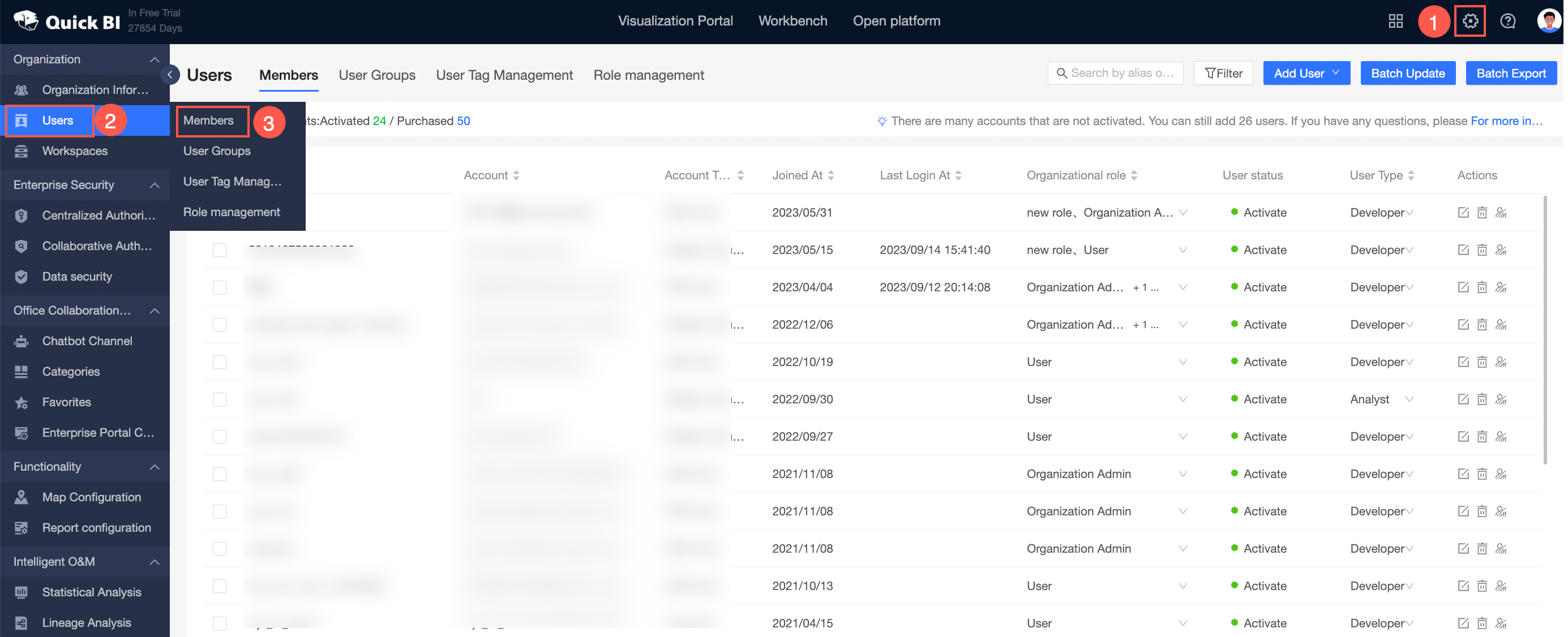
In the upper-right corner of the Members tab, choose .
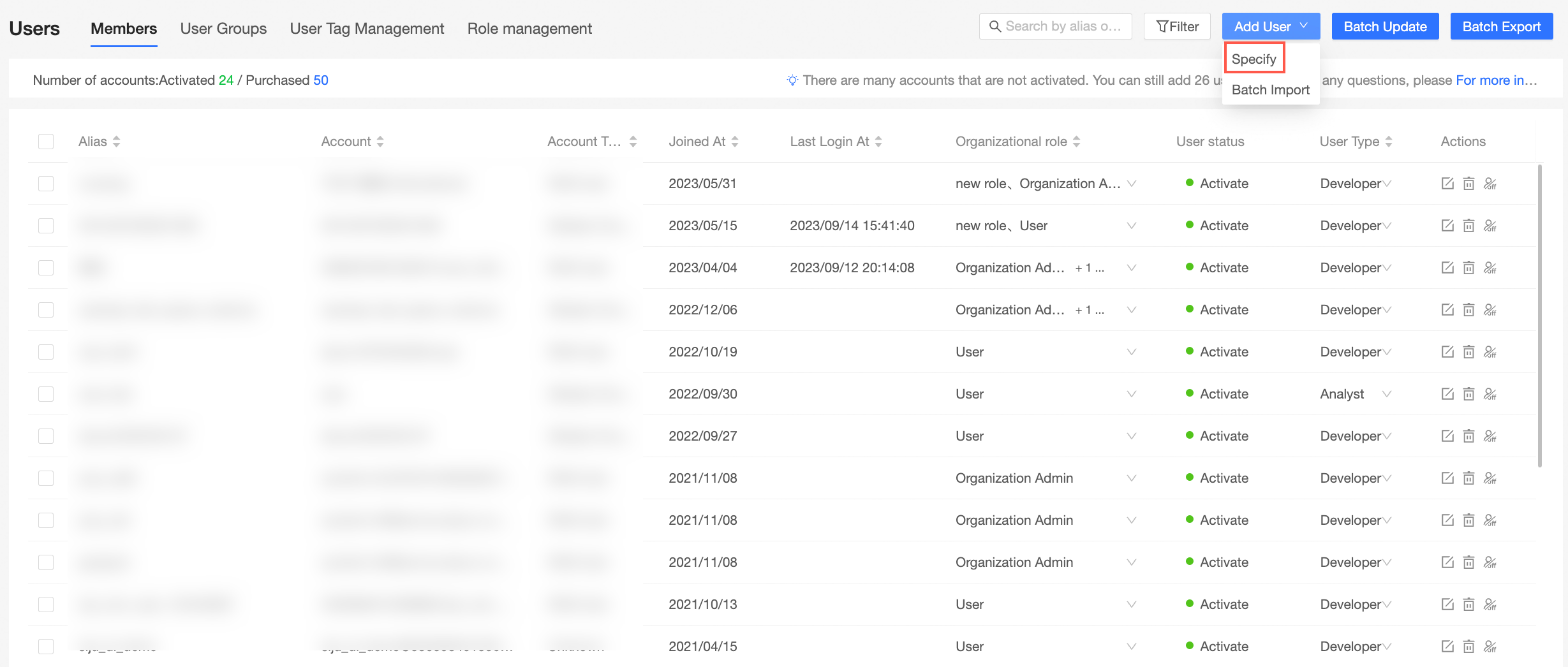
In the Add User dialog box, set Account Type to Alibaba Cloud Account and configure the following parameters.
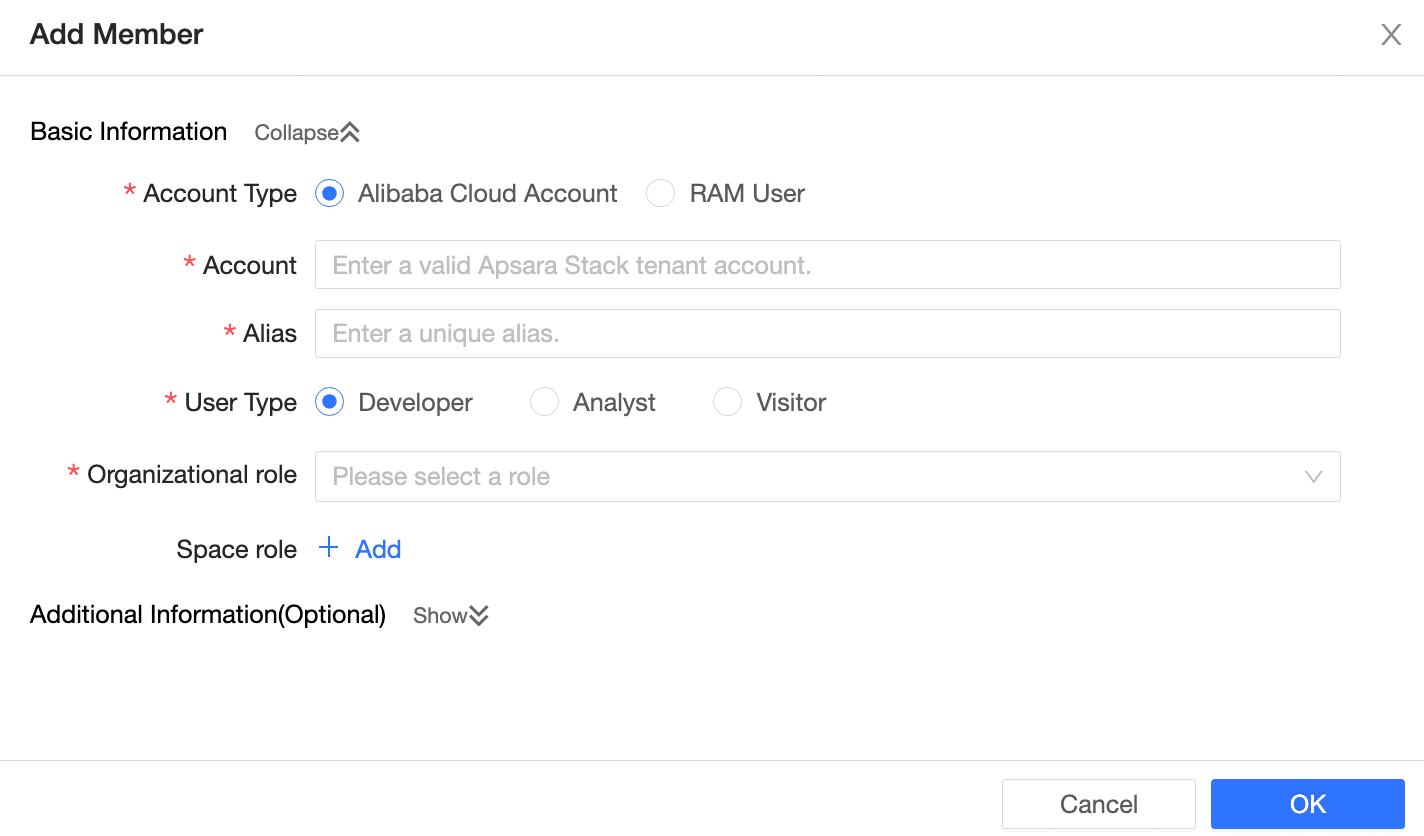
Section
Parameter
Required
Description
Basic Info
Alibaba Cloud account
Yes
The Alibaba Cloud account that you want to add. For more information, see Obtain an Alibaba Cloud account.
Nickname
Yes
The alias of the Alibaba Cloud account that is used in Quick BI. You can customize the alias.
An alias must be 1 to 50 characters in length. It can contain only letters, digits, and the following special characters: _ / \ | ( ) [ ]
Type of User
Yes
Both developer and visitor types are supported:
Developers: enterprise IT personnel, data analysts, and data operations personnel.
Visitors: users who can view reports, such as bosses and leaders, or front-line business personnel who can only view data results. Visitors can subscribe to and view dashboards, workbooks, and BI portals. Visitors can also use URLs to view these data objects.
Organization Role
Yes
At the organization level, three preset organization roles are available. You can add custom organization roles.
Organization Administrator: manages the information, status, and members of a project. Organization administrators can specify an organization user as an organization administrator.
We recommend that one to three users assume the organization administrator role. In most cases, project managers and personnel that are responsible for the Quick BI platform assume this role.
Permission Administrator: allows you to manage project resources. We recommend that one to three users assume the permission administrator role. In most cases, the personnel that are responsible for the Quick BI platform assume this role. The permission administrator grants the user account the permission administrator role, which is mainly responsible for uniformly assigning and managing permissions in the background.
common user: Users who have not been set up as organization administrators and permission administrators.
Custom Organization Role: You can customize an organization role based on your business requirements. For more information, see Organization roles.
Workspace Roles
No
At the spatial level, there are four preset spatial roles. You can add custom spatial roles.
The workspace administrator has the permissions to create, edit, and view all modules. The workspace administrator is the role that has the most permissions in the current workspace. In addition to the preceding permissions, the workspace administrator can manage the permissions and works of other members in the workspace.
The workspace developer has the permissions to create, edit, and view all modules.
Spatial analysts have the permissions to create (edit) and view BI portal, dashboards, dashboards, workbooks, ad hoc analysis, self-service data retrieval, and data preparation modules, view data forms and data sources, and use and view datasets.
The workspace viewer has the permissions to view all modules.
Custom Workspace Role: You can create custom workspace roles based on your business requirements. For more information, see Space roles.
Additional Information
User Group
No
The user group to which the Alibaba Cloud account belongs.
Click OK.
Add Alibaba Cloud accounts at a time
After you log on to the Quick BI console.
On the Quick BI homepage, follow the instructions in the following figure to go to the User Management page.
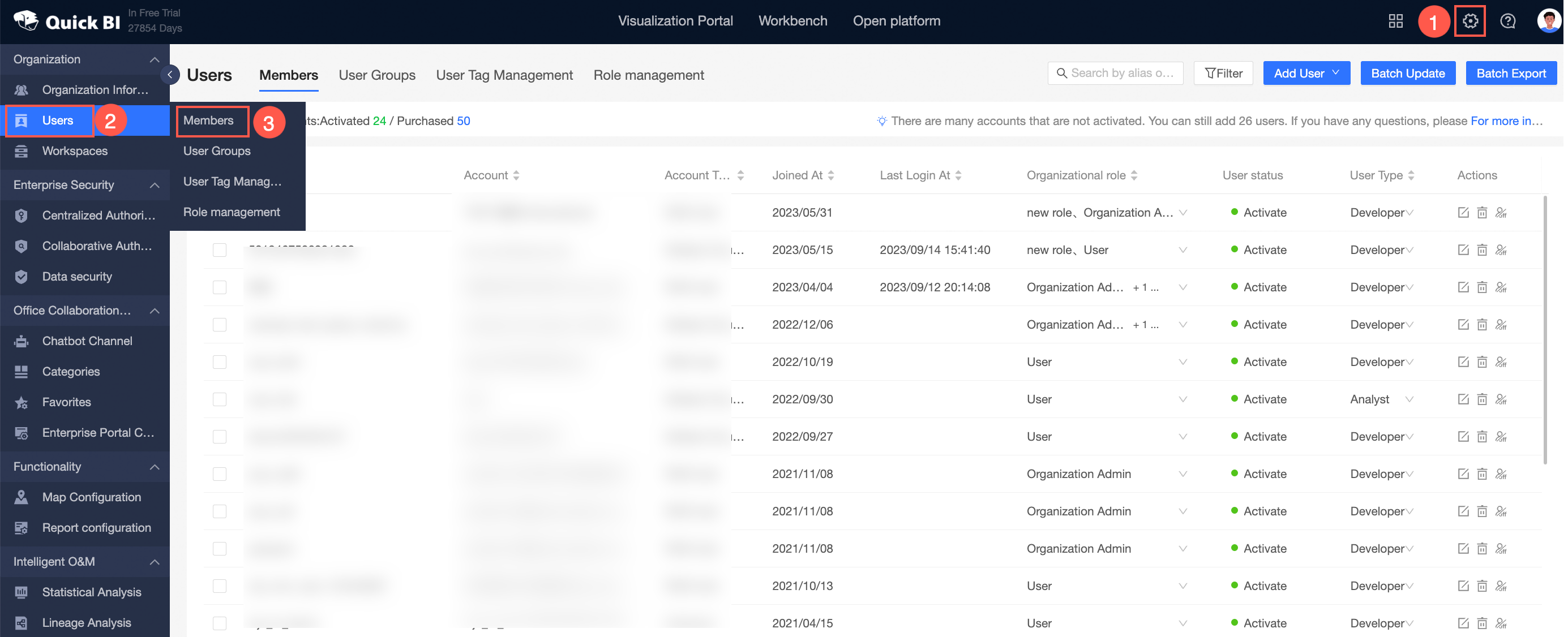
In the upper-right corner of the Members tab, choose .
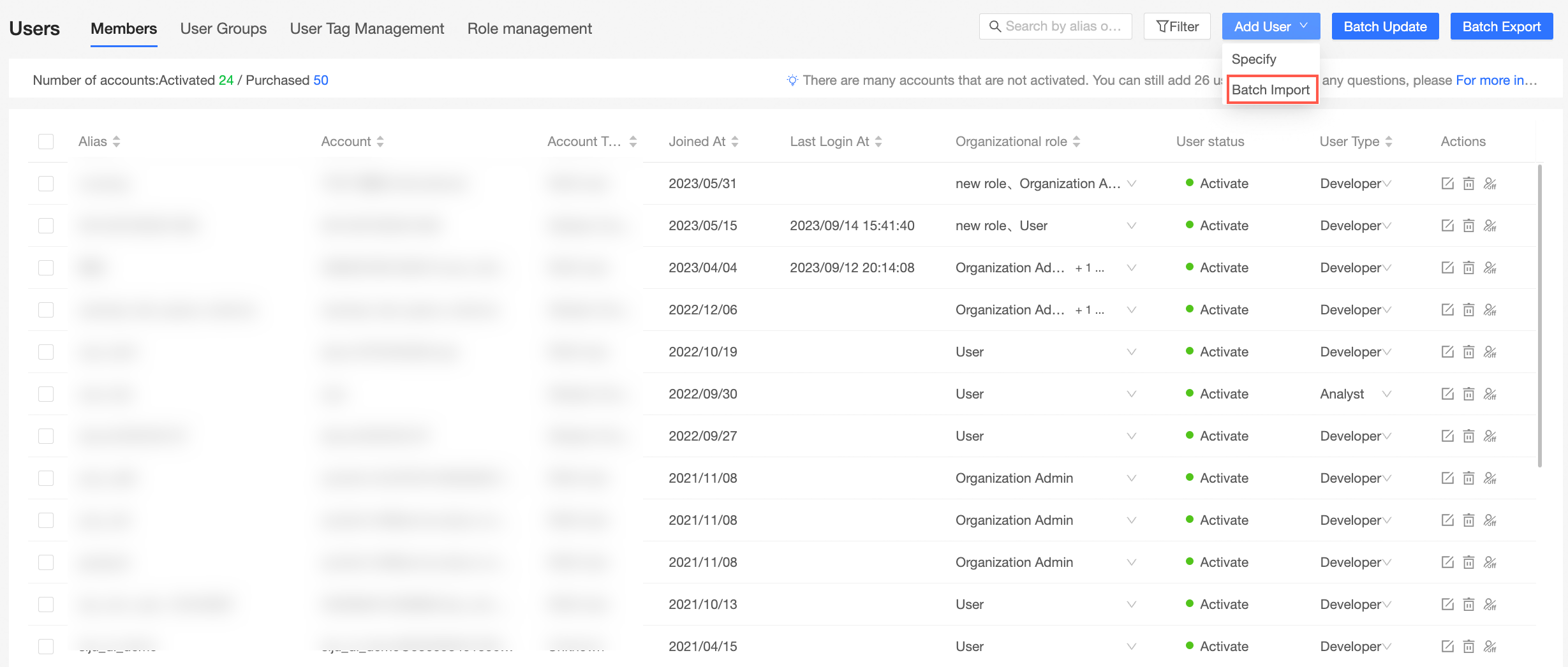
In the Batch Add User Information dialog box, click Get Batch Add User Information Template to download the user information template.
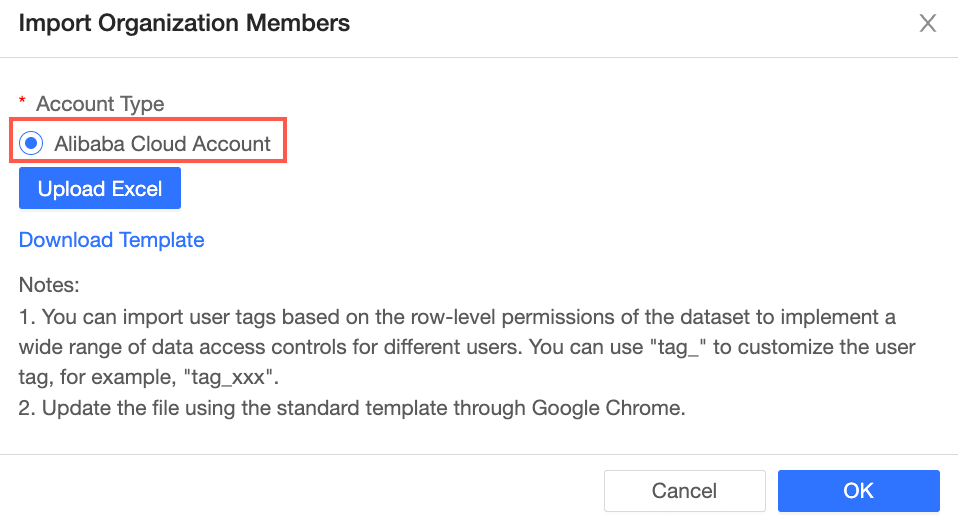
Enter the user information in the template and save the information to the template.
The following table describes the key fields in the template.
Field
Required
Description
Username
Yes
You can use the Alibaba Cloud account to which the RAM user belongs.
If the organization user that you want to add uses an Alibaba Cloud account such as main_account, enter the Alibaba Cloud account such as main_account.
If the organization user is a RAM user, such as sub_account1, and the Alibaba Cloud account main_account is used as the RAM user, the format of the Alibaba Cloud account is Alibaba Cloud account: RAM user. For example, enter main_account:sub_account1.
Alias
Yes
The alias of the Alibaba Cloud account that is used in Quick BI. You can customize the alias.
An alias must be 1 to 50 characters in length. It can contain only letters, digits, and the following special characters: _ / \ | ( ) [ ]
user type
Yes
The developer and visitor types are supported. Valid values:
Developers: can be added as members of a workspace and granted the permissions to develop and manage data.
Visitors cannot be added as workspace members and can only view specific reports.
The role of the user.
Yes
At the organization level, three preset organization roles are available. You can add custom organization roles.
Organization Administrator: manages the information, status, and members of a project. Organization administrators can specify an organization user as an organization administrator.
We recommend that one to three users assume the organization administrator role. In most cases, project managers and personnel that are responsible for the Quick BI platform assume this role.
Permission Administrator: allows you to manage project resources. We recommend that one to three users assume the permission administrator role. In most cases, the personnel that are responsible for the Quick BI platform assume this role. The permission administrator grants the user account the permission administrator role, which is mainly responsible for uniformly assigning and managing permissions in the background.
common user: Users who have not been set up as organization administrators and permission administrators.
Custom Organization Role: You can customize an organization role based on your business requirements. For more information, see Organization roles.
The email address of the user.
No
The email address that is bound to the Alibaba Cloud account when the account is created.
Phone
No
The phone number that is bound to the Alibaba Cloud account when the account is created.
user-group
No
The user group to which the Alibaba Cloud account belongs.
tag_example
No
You can customize tags for members. Tag names must start with tag_, such as tag_example.
Valid values:
$ALL_MEMBERS$: the permissions to access all data.
A custom value. For example, north specifies the permissions to access data in the north region.
NoteIf you want to specify multiple permissions in a tag, separate the permissions with commas (,). For example, enter north,east.
Click Select Excel File to upload the user information.
We recommend that you use the Chrome browser to upload the template.
Before you upload the file, we recommend that you click Download Template to obtain a template. Then, enter the user information in the template based on the template requirements.
To avoid attachment upload failures, check the attachment to ensure that the content does not appear in the following situations:
An account user in the file exists in the organization and cannot be added repeatedly.
An account alias in the file exists in the organization.
A user group path in the file does not exist.
The number of Excel rows exceeds 5000.
The order of columns except the tag_ column is changed.
The number of users to be added exceeds the licensed number.
For more information about the licensed number of users in each Quick BI edition, see License quota.
Click OK.